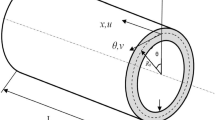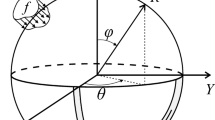Abstract
In this paper, an approximate energy flow model for the out-of-plane vibration of a finite thin shell was developed. The derived energy governing equation for the model was expressed in terms of the time- and locally space-averaged far-field wave energy density which can be used as the main equation for the prediction of the out-of-plane structural vibration levels of the energy density and intensity in medium-to-high frequency ranges. The derived model can be applied to the vibration energy problems of a cylindrical shell, spherical shell and doubly-curved shell, whose radius of curvature in each direction is constant, regardless of the position, assuming that the in-plane motion is relatively small. To verify the results of the derived model, wave numbers were obtained using an energy flow analysis and classical analysis, such as the method using Donnell-Mushtari equations. For the case of various types of finite thin shell, the derived energy equations were applied. The results for the spatial distributions and levels of the energy density and intensity were compared with classical displacement solutions, according to the changes in the frequency and internal loss factor of the shell.
Similar content being viewed by others
References
V. D. Belov, S. A. Rybak and B. D. Tartakovskii, Propagation of vibrational energy in absorbing structures, Soviet-Physics Acoustics, 23 (1977) 115–119.
D. J. Nefske and S. H. Sung, Power flow finite element analysis of dynamic systems: basic theory and application to beam, Journal of Vibration, Acoustics, Stress and Reliability in Design, 111 (1989) 94–100.
J. C. Wohlever and R. J. Bernhard, Mechanical energy flow models of rods and beams, Journal of Sound and Vibration, 153 (1992) 1–19.
O. M. Bouthier and R. J. Bernhard, Models of space-averaged energetics of plates, AIAA Journal, 30 (1992) 616–623.
P. E. Cho, Energy flow analysis of coupled structures, Ph. D. Thesis, Purdue University (1993).
D.-H. Park, S.-Y. Hong, H.-G. Kil and J.-J. Jeon, Power flow models and analysis of inplane waves in finite coupled thin plates, Journal of Sound and Vibration, 244 (2001) 651–668.
D.-H. Park, S.-Y. Hong and H.-G. Kil, Vibrational energy flow models of finite ortho-tropic plates, Shock and Vibration, 10 (2003) 97–113.
Y.-H. Park and S.-Y. Hong, Vibrational energy flow analysis of corrected flexural waves in Timoshenko beam — Part I: Theory of an energetic model, Shock and Vibration, 13 (2006) 137–165.
Y.-H. Park and S.-Y. Hong, Vibrational energy flow analysis of corrected flexural waves in Timoshenko beam — Part II: Application to coupled Timoshenko beams, Shock and Vibration, 13 (2006) 167–196.
Y.-H. Park and S.-Y. Hong, Vibrational power flow models for transversely vibrating finite Mindlin plate, Journal of Sound and Vibration, 317 (2008) 800–840.
J.-H. Song and S.-Y. Hong, Development of nonconservative joints in beam networks for vibration energy flow analysis, Shock and Vibration, 14 (2007) 15–28.
J.-H. Song, S.-Y. Hong, Y. Kang and H.-G. Kil, Vibrational energy flow analysis of penetration beam-plate coupled structures, Journal of Mechanical Science and Technology, 25(3) (2011) 567–576.
A. Leissa, Vibration of Shells, Acoustic Society of America, 1993.
S. Timoshenko, Theory of Plates and Shells, New York McGraw-Hill, 1940.
L. Cremer, M. Heckl and E. E. Ungar, Structure-born sound, Berlin: Springer-Verlag (1988).
Author information
Authors and Affiliations
Corresponding author
Additional information
This paper was recommended for publication in revised form by Associate Editor Cheolung Cheong
Hyun-Wung Kwon received his B.S. degree in Naval Architecture and Ocean Engineering from the Seoul National University, Korea, in 2004 and his Ph.D. in 2009. Currently he is a postdoctoral researcher at Research Institute of Marine Systems Engineering (RIMSE) of Seoul National University, Korea. His primary research interest is energy flow analysis in structures and acoustics.
Jee-Hun Song received his B.S. degree in Naval Architecture and Ocean Engineering from the Seoul National University, Korea, in 2003, and his Ph.D. in 2007. Currently he is a professor of Naval Architecture and Ocean Engineering at Chonnam National University, Korea. His primary research interest is energy flow analysis in structures.
Rights and permissions
About this article
Cite this article
Kwon, H.W., Hong, S.Y., Park, D.H. et al. Vibrational energy flow models for out-of-plane waves in finite thin shell. J Mech Sci Technol 26, 689–701 (2012). https://doi.org/10.1007/s12206-011-1229-7
Received:
Revised:
Accepted:
Published:
Issue Date:
DOI: https://doi.org/10.1007/s12206-011-1229-7




